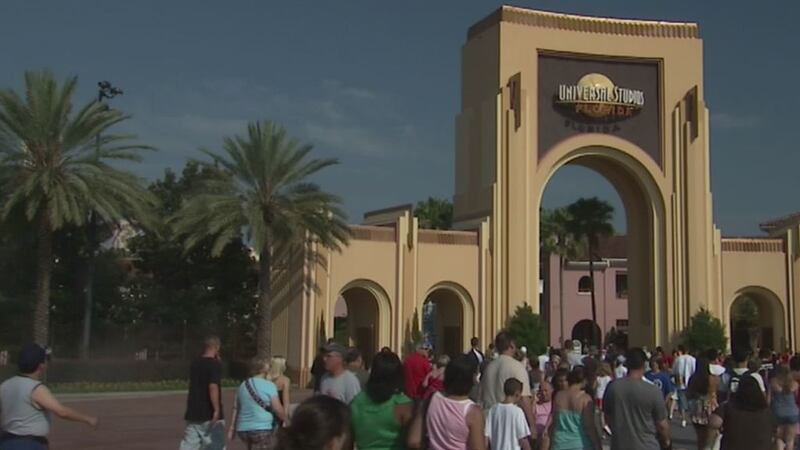FILL THIS OUT — Orlando is not a hard sell for tourists, but it only took a few weeks for the coronavirus to cripple the area’s economy.
Though businesses will start to reopen with limited capacity over the next few weeks, the damage may have already been done to so many.
Central Florida, specifically Orange and Osceola counties, which rely heavily on tourism, has lost hundreds of millions in sales and tourist development taxes.
READ: LIVE UPDATES: Orange County libraries to start delivering books again next week
“We love Orlando. We have two little ones and both girls love Disney, so we planned two trips to Orlando this year,” Shayla Williamson told Channel 9 investigative reporter Daralene Jones.
Romerio and Shayla Williamson live in Memphis, Tennessee, and had two trips planned to Orlando this year but cancelled both as the coronavirus spread. They work in health care and have firsthand knowledge of the virus.
As a nurse, Shayla Williamson has been treating patients and administering COVID-19 tests for weeks.
The couple said it could be a year or longer before they're comfortable returning to a city that attracts 75 million tourists a year.
“(There are) changes we would have to go through as far as navigating the airport while practicing extreme hand hygiene as well as wearing masks," Shayla Williamson said. “Our smallest baby is turning 3 this year, that’s another dynamic as far as touching surfaces, touching her face, hands.”
Orange County Mayor Jerry Demings said he is aware of the challenge to restore consumer confidence.
READ: Not able to pay off all your bills? Here’s which ones experts say you should prioritize first
“They still don't want to go sit down in a crowded restaurant and still there are people may not want to go back to work, normal jobs because of fear. So we have to deal with all of that,” Demings said during a wide-ranging interview with Jones.
9 Investigates calculated the sales tax typically collected between January and May in Orange and Osceola counties, areas with the most tourist attractions. That revenue has increased each of the last three years from $1.35 billion in 2017 to $1.52 billion last year, and the cash collected usually picks up in March, which is when the local economy shut down.
President and CEO of Visit Orlando George Aguel said the agency is already recalibrating a campaign message to get tourists back because its research shows that 72% of Americans still plan to travel within the next six months.
“We were already planning another campaign to go forward with, and what we’ve had to do is pause that,” Aguel said. “We’re recalibrating a campaign message that we think is really going to resonate with consumers.”
Jones asked what markets they plan to tap into right away.
“Most folks don’t realize that over 70% of all of the visitors that come here, drive here, so think of the significance of that,” Aguel said.
Aguel said Visit Orlando is unique in that the agency gets its funding from the tourist development tax, which is anticipated to be lower than normal in March, April and May.
“The more tourists that come, the more tourist development tax,” Aguel said.
READ: Phased reopening a scary prospect for Halloween-themed bar in Orlando
New campaigns will also target younger adults instead of solely mothers with children, which is the group typically targeted. Since the TDT is expected to be down, Visit Orlando, will have to market with less revenue.
It received $65.4 million through the TDT last fiscal year. But a few months ago, a county board voted to increase its disbursements over the next five years, Visit Orlando will receive 30% of the TDT revenue instead of 25%.
The Orange County comptroller said this week that the TDT budget had $81 million in its debt reserve, which can’t be touched because it is needed to pay for one year’s worth of debt payments. And another $244 million in renewal and replacement reserves, which is basically a rainy-day fund or fluctuations in cases where the TDT drops, or it can be used for improvements to venues.
Airlines have already reduced flights to Orlando. Air travel continues to be down about 95-96%. That’s a problem for the airport, which has a budget that is not reliant on taxes, but solely vendor and airline fees.
In a recent board meeting, Orlando International Airport CEO Phil Brown told board members the airport is losing about $17 million a month because most restaurants, rental facilities and other vendors weren’t operating and put in requests for fee abatements.
“1.8 million seats are coming out of the Orlando market over the next year. A million of that will happen in the month of May so that means less flights are coming in,” Brown told Jones.
And to change that, there has to be demand from people like the Williamson family, which could be tough.
Shayla Williamson said it could be a year or longer before her family feels comfortable traveling, again.
READ: How soon could theme parks reopen? Officials provide no clear timeline
“My husband and I, we’ve discussed it. Ideally, we would like to make sure there hasn’t been any new diagnosis of COVID-19 patients for a 14 to 28 day period before we would feel comfortable traveling,” Shayla Williamson said.
This week, Visit Orlando, in partnership with Orange County government, launched the “407Dates” campaign, named after the longtime Orange County area code.
Restaurants may begin offering indoor seating at 25% capacity beginning, but they said takeout and delivery services continue to be important to serve residents and support local businesses.
“During this uncertain time, it is more important than ever to take a moment to relax with your spouse or significant other in your life,” Demings said.
© 2020 Cox Media Group








